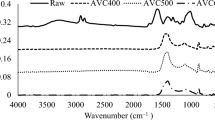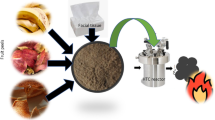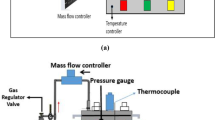Abstract
The usage of orange peel wastes for solid biofuel production can provide a sustainable solution for solid waste management while also reducing the negative effects of fossil fuels. The aim of this study is to compare the combustion properties of orange peel wastes and solid biofuels obtained from them. In this context, the combustion behaviour of orange peel wastes and hydrochar and biochar samples obtained as a result of their hydrothermal carbonization and pyrolysis were investigated by the thermogravimetric method in this study. In addition, the combustion kinetics of these fuels were determined using the Kissinger-Akahira-Sunosa (KAS) and Flynn–Wall–Ozawa (FWO) methods. As a result of the thermogravimetric analysis, it is seen that the combustion behavior of raw biomass and hydrochar are quite similar, but the combustion of biochar is different from them. The combustion of raw waste and its hydrochar took place in multiple steps, the combustion of biochar took place in a single step. While the average combustion activation energy values of orange peel, hydrochar and biochar were calculated by KAS method as 159.876, 208.561 and 77.656 kJ/mol, respectively; they were calculated by the FWO method as 161.717, 208.600 and 85.209 kJ/mol, respectively. According to these results, the production of biochar from orange peel wastes by pyrolysis and the use of the obtained biochars in combustion systems are more suitable in terms of energy efficiency. Future research of the combustion of solid biofuels from orange peel will be very important to determine their potential for use in combustion systems, either directly or as an additive, and to increase energy efficiency.
Graphical abstract






Similar content being viewed by others
Data availability
Data will be provided upon request.
References
Kumar Sarangi P, Subudhi S, Bhatia L et al (2022) Utilization of agricultural waste biomass and recycling toward circular bioeconomy. Environ Sci Pollut Res 30:8526–8539. https://doi.org/10.1007/s11356-022-20669-1
Perez-Pirotto C, Cozzano S, Hernando I, Arcia P (2023) Different green extraction technologies for soluble dietary fibre extraction from orange by-product. Int J Food Sci Technol 58:2042–2049. https://doi.org/10.1111/ijfs.15756
Su G, Chan C, He J (2022) Enhanced biobutanol production from starch waste via orange peel do**. Renew Energy 193:576–583. https://doi.org/10.1016/j.renene.2022.04.096
Otieno OD, Mulaa FJ, Obiero G, Midiwo J (2022) Utilization of fruit waste substrates in mushroom production and manipulation of chemical composition. Biocatal Agric Biotechnol 39:102250. https://doi.org/10.1016/j.bcab.2021.102250
Kotsampasi B, Tsiplakou E, Christodoulou C et al (2018) Effects of dietary orange peel essential oil supplementation on milk yield and composition, and blood and milk antioxidant status of dairy ewes. Anim Feed Sci Technol 245:20–31. https://doi.org/10.1016/j.anifeedsci.2018.08.007
**ao K, Liu H, Li Y et al (2018) Correlations between hydrochar properties and chemical constitution of orange peel waste during hydrothermal carbonization. Bioresour Technol 265:432–436. https://doi.org/10.1016/j.biortech.2018.06.014
Santos CM, Dweck J, Viotto RS et al (2015) Application of orange peel waste in the production of solid biofuels and biosorbents. Bioresour Technol 196:469–479. https://doi.org/10.1016/j.biortech.2015.07.114
Koçer AT, Mutlu B, Özçimen D (2020) Investigation of biochar production potential and pyrolysis kinetics characteristics of microalgal biomass. Biomass Convers Biorefinery 10:85–94. https://doi.org/10.1007/s13399-019-00411-7
Li J, Pan L, Suvarna M et al (2020) Fuel properties of hydrochar and pyrochar: Prediction and exploration with machine learning. Appl Energy 269:115166. https://doi.org/10.1016/j.apenergy.2020.115166
Tarhan SZ, Koçer AT, Özçimen D, Gökalp İ (2021) Cultivation of green microalgae by recovering aqueous nutrients in hydrothermal carbonization process water of biomass wastes. J Water Process Eng 40:101783. https://doi.org/10.1016/j.jwpe.2020.101783
Wang Q, Wu S, Cui D et al (2022) Co-hydrothermal carbonization of organic solid wastes to hydrochar as potential fuel: A review. Sci Total Environ 850:158034. https://doi.org/10.1016/j.scitotenv.2022.158034
Koçer AT, Özçimen D (2022) Experimental investigation on thermal behavior and thermo-kinetic study on pyrolysis of de-oiled microalgae. Int J Environ Sci Technol 19:12279–12288. https://doi.org/10.1007/s13762-022-03933-2
Chen W, Meng J, Han X et al (2019) Past, present, and future of biochar. Biochar 1:75–87
Koçer AT, Özçimen D (2021) Determination of combustion characteristics and kinetic parameters of Ulva lactuca and its biochar. Biomass Convers Biorefinery. https://doi.org/10.1007/s13399-020-01245-4
Riaz S, Al-Abdeli YM, Oluwoye I (2023) Partially Oxidative Torrefaction of Woody Biomass Pellets: Burning Behaviour and Emission Analysis. Bioenergy Res. https://doi.org/10.1007/s12155-023-10572-z
Fan F, Zheng Y, Huang Y et al (2017) Combustion Kinetics of Biochar Prepared by Pyrolysis of Macadamia Shells. Bio Res 12:3918–3932. https://doi.org/10.15376/biores.12.2.3918-3932
Arauzo PJ, Atienza-Martínez M, Ábrego J et al (2020) Combustion characteristics of hydrochar and pyrochar derived from digested sewage sludge. Energies 13:4164. https://doi.org/10.3390/en13164164
Zhu G, Yang L, Gao Y et al (2019) Characterization and pelletization of cotton stalk hydrochar from HTC and combustion kinetics of hydrochar pellets by TGA. Fuel 244:479–491. https://doi.org/10.1016/j.fuel.2019.02.039
Lang Q, Zhang B, Liu Z et al (2019) Co-hydrothermal carbonization of corn stalk and swine manure: Combustion behavior of hydrochar by thermogravimetric analysis. Bioresour Technol 271:75–83. https://doi.org/10.1016/j.biortech.2018.09.100
Ro KS, Libra JA, Bae S et al (2019) Combustion Behavior of Animal-Manure-Based Hydrochar and Pyrochar. ACS Sustain Chem Eng 7:470–478. https://doi.org/10.1021/acssuschemeng.8b03926
Yang X, Wang X, Zhao B, Li Y (2014) Simulation Model of Pyrolysis Biofuel Yield Based on Algal Components and Pyrolysis Kinetics. Bioenergy Res 7:1293–1304. https://doi.org/10.1007/s12155-014-9467-z
Vyazovkin S, Wight CA (1999) Model-free and model-fitting approaches to kinetic analysis of isothermal and nonisothermal data. Thermochim Acta 340–341:53–68. https://doi.org/10.1016/S0040-6031(99)00253-1
Tariq R, Mohd Zaifullizan Y, Salema AA et al (2022) Co-pyrolysis and co-combustion of orange peel and biomass blends: Kinetics, thermodynamic, and ANN application. Renew Energy 198:399–414. https://doi.org/10.1016/j.renene.2022.08.049
Sobek S, Tran QK, Junga R, Werle S (2022) Hydrothermal carbonization of the waste straw: A study of the biomass transient heating behavior and solid products combustion kinetics. Fuel 314:122725. https://doi.org/10.1016/j.fuel.2021.122725
Barbanera M, Cotana F, Di Matteo U (2018) Co-combustion performance and kinetic study of solid digestate with gasification biochar. Renew Energy 121:597–605. https://doi.org/10.1016/j.renene.2018.01.076
Liu H, Zhang S, Feng S, Jia C, Guo S, Sun B, Wang Q (2021) Combustion characteristics and typical pollutant emissions of corn stalk blending with municipal sewage sludge. Environ Sci Pollut Res 28:9792–9805. https://doi.org/10.1007/s11356-020-11463-y
García R, Pizarro C, Lavín AG, Bueno JL (2012) Characterization of Spanish biomass wastes for energy use. Bioresour Technol 103:249–258. https://doi.org/10.1016/j.biortech.2011.10.004
Nhuchhen DR (2016) Prediction of carbon, hydrogen, and oxygen compositions of raw and torrefied biomass using proximate analysis. Fuel 180:348–356. https://doi.org/10.1016/j.fuel.2016.04.058
Parikh J, Channiwala SA, Ghosal GK (2005) A correlation for calculating HHV from proximate analysis of solid fuels. Fuel 84:487–494. https://doi.org/10.1016/j.fuel.2004.10.010
Ali I, Bahadar A (2019) Thermogravimetric characteristics and non-isothermal kinetics of macro-algae with an emphasis on the possible partial gasification at higher temperatures. Front Energy Res 7:7. https://doi.org/10.3389/fenrg.2019.00007
Vyazovkin S, Burnham AK, Criado JM et al (2011) ICTAC Kinetics Committee recommendations for performing kinetic computations on thermal analysis data. Thermochim Acta 520:1–19
Hu Y, Wang Z, Cheng X, Ma C (2018) Non-isothermal TGA study on the combustion reaction kinetics and mechanism of low-rank coal char. RSC Adv 8:22909–22916. https://doi.org/10.1039/C8RA02618A
Kissinger HE (1957) Reaction Kinetics in Differential Thermal Analysis. Anal Chem 29:1702–1706. https://doi.org/10.1021/ac60131a045
Flynn JH, Wall LA (1966) A quick, direct method for the determination of activation energy from thermogravimetric data. J Polym Sci Part B Polym Lett 4:323–328. https://doi.org/10.1002/pol.1966.110040504
Ozawa T (1965) A New Method of Analyzing Thermogravimetric Data. Bull Chem Soc Jpn 38:1881–1886. https://doi.org/10.1246/bcsj.38.1881
Yu KL, Show PL, Ong HC et al (2018) Biochar production from microalgae cultivation through pyrolysis as a sustainable carbon sequestration and biorefinery approach. Clean Technol Environ Policy 20:2047–2055. https://doi.org/10.1007/s10098-018-1521-7
Demirbaş A (2003) Relationships between heating value and lignin, fixed carbon, and volatile material contents of shells from biomass products. Energy Sources 25:629–635. https://doi.org/10.1080/00908310390212336
Ortiz-Sanchez M, Solarte-Toro JC, Orrego-Alzate CE et al (2021) Integral use of orange peel waste through the biorefinery concept: an experimental, technical, energy, and economic assessment. Biomass Convers Biorefinery 11:645–659. https://doi.org/10.1007/s13399-020-00627-y
Alvarez J, Hooshdaran B, Cortazar M et al (2018) Valorization of citrus wastes by fast pyrolysis in a conical spouted bed reactor. Fuel 224:111–120. https://doi.org/10.1016/j.fuel.2018.03.028
Sial TA, Lan Z, Khan MN et al (2019) Evaluation of orange peel waste and its biochar on greenhouse gas emissions and soil biochemical properties within a loess soil. Waste Manag 87:125–134. https://doi.org/10.1016/j.wasman.2019.01.042
Erdogan E, Atila B, Mumme J et al (2015) Characterization of products from hydrothermal carbonization of orange pomace including anaerobic digestibility of process liquor. Bioresour Technol 196:35–42. https://doi.org/10.1016/j.biortech.2015.06.115
Yaradoddi JS, Banapurmath NR, Ganachari SV et al (2021) Bio-based material from fruit waste of orange peel for industrial applications. J Mater Res Technol. https://doi.org/10.1016/j.jmrt.2021.09.016
Koçer AT, İnan B, Kaptan Usul S et al (2021) Exopolysaccharides from microalgae: production, characterization, optimization and techno-economic assessment. Brazilian J Microbiol 52:1779–1790. https://doi.org/10.1007/s42770-021-00575-3
Zapata B, Balmaseda J, Fregoso-Israel E, Torres-García E (2009) Thermo-kinetics study of orange peel in air. J Therm Anal Calorim 98:309–315. https://doi.org/10.1007/s10973-009-0146-9
Wang X, Hu Z, Deng S et al (2015) Kinetics investigation on the combustion of biochar in O2/CO2 atmosphere. Environ Prog Sustain Energy 34:923–932. https://doi.org/10.1002/ep.12063
Mohan D, Pittman CU, Steele PH (2006) Pyrolysis of wood/biomass for bio-oil: A critical review. Energy Fuels 20:848–889
Espro C, Satira A, Mauriello F et al (2021) Orange peels-derived hydrochar for chemical sensing applications. Sensors Actuators B Chem 341:130016. https://doi.org/10.1016/j.snb.2021.130016
Li Y, Liu H, **ao K et al (2020) Combustion and Pyrolysis Characteristics of Hydrochar Prepared by Hydrothermal Carbonization of Typical Food Waste: Influence of Carbohydrates, Proteins, and Lipids. Energy Fuels 34:430–439. https://doi.org/10.1021/acs.energyfuels.9b02940
Boumanchar I, Chhiti Y, M’hamdiAlaoui FE et al (2019) Investigation of (co)-combustion kinetics of biomass, coal and municipal solid wastes. Waste Manag 97:10–18. https://doi.org/10.1016/j.wasman.2019.07.033
**ang Y, **ang Y, Wang L (2016) Thermal decomposition kinetic of hybrid poplar sawdust as biomass to biofuel. J Environ Chem Eng 4:3303–3308. https://doi.org/10.1016/j.jece.2016.07.009
Yang W, Wang H, Zhang M et al (2016) Fuel properties and combustion kinetics of hydrochar prepared by hydrothermal carbonization of bamboo. Bioresour Technol 205:199–204. https://doi.org/10.1016/j.biortech.2016.01.068
Peterson CA, Brown RC (2020) Oxidation kinetics of biochar from woody and herbaceous biomass. Chem Eng J 401:126043. https://doi.org/10.1016/j.cej.2020.126043
Lee XJ, Ong HC, Gao W et al (2021) Solid biofuel production from spent coffee ground wastes: Process optimisation, characterisation and kinetic studies. Fuel 292:120309. https://doi.org/10.1016/j.fuel.2021.120309
Lee XJ, Lee LY, Hiew BYZ et al (2020) Valorisation of oil palm wastes into high yield and energy content biochars via slow pyrolysis: Multivariate process optimisation and combustion kinetic studies. Mater Sci Energy Technol 3:601–610. https://doi.org/10.1016/j.mset.2020.06.006
Acknowledgements
Anıl Tevfik Koçer was supported by The Scientific and Technological Research Council of Turkey (National Scholarship Programme for Doctorate Students) and 100/2000 The Council of Higher Education Doctorate Scholarship Programme. Didem Özçimen was supported by the French Embassy in Turkey and the CNRS for her scholarship at ICARE-CNRS, Orl´eans.
Funding
No funding.
Author information
Authors and Affiliations
Contributions
Anıl Tevfik Koçer: Conceptualization, Methodology, Formal analysis, Investigation, Visualization, Writing- Original draft. Didem Özçimen: Funding acquisition, Resources, Supervision, Writing – review & editing. İskender Gökalp: Supervision, Writing – review & editing.
Corresponding author
Ethics declarations
Ethical approval
Not applicable.
Competing interests
All the authors declare that they have no competing interests.
Additional information
Publisher's note
Springer Nature remains neutral with regard to jurisdictional claims in published maps and institutional affiliations.
Rights and permissions
Springer Nature or its licensor (e.g. a society or other partner) holds exclusive rights to this article under a publishing agreement with the author(s) or other rightsholder(s); author self-archiving of the accepted manuscript version of this article is solely governed by the terms of such publishing agreement and applicable law.
About this article
Cite this article
Koçer, A.T., Özçimen, D. & Gökalp, İ. An experimental study on the combustion behaviours of orange peel-based solid biofuels. Biomass Conv. Bioref. (2023). https://doi.org/10.1007/s13399-023-04406-3
Received:
Revised:
Accepted:
Published:
DOI: https://doi.org/10.1007/s13399-023-04406-3




